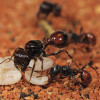New approach to battling flu - Scientists have developed a new class of flu vaccines that might help to contain a future pandemic. Writing in this weeks PNAS New York-based researcher David Ho and his team have used DNA coding for part of the surface coat of flu viruses to protect mice against a lethal dose of the infection. Previously the best way to protect against the flu was to grow the virus in hens' eggs before chemically inactivating and purifying it to turn it into material that could safely be injected. But a major problem with this approach is that it takes a long time to produce the vaccine and, when injected, it tends to trigger a highly focused immune response against just that one form of the flu. As a result the vaccine regularly needs updating to ensure that it protects against new strains produced when the virus mutates, which it does continuously. To get around this problem the US team, who are based at Rockefeller University, first built a genetic family tree from 467 different strains of the H5N1 flu virus. This enabled them to home in on a part of the flu genome at the root of the family tree that was the same amongst the majority of the different viral strains. The team then produced a DNA sequence coding for this part of the viral genome, which was from the main surface protein called HA. Mice injected with this DNA sequence produced large amounts of antibody and white blood cells that could neutralise a range of H5N1 strains. Most encouragingly, when mice were infected with lethal doses of virus that killed control animals those previously given the new vaccine all survived. According to the researchers, their vaccine strategy offers a fast and affordable way to combat H5N1, viewed by many as the best contender to cause the next pandemic.










Comments
Add a comment